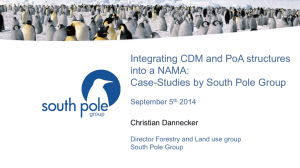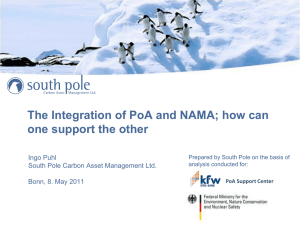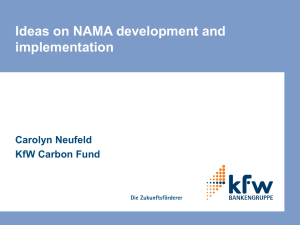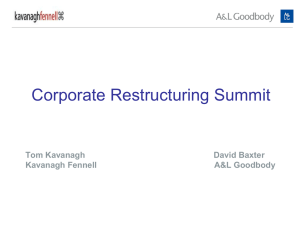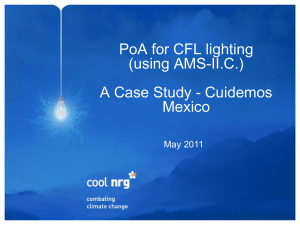South Pole Company Presentation
advertisement
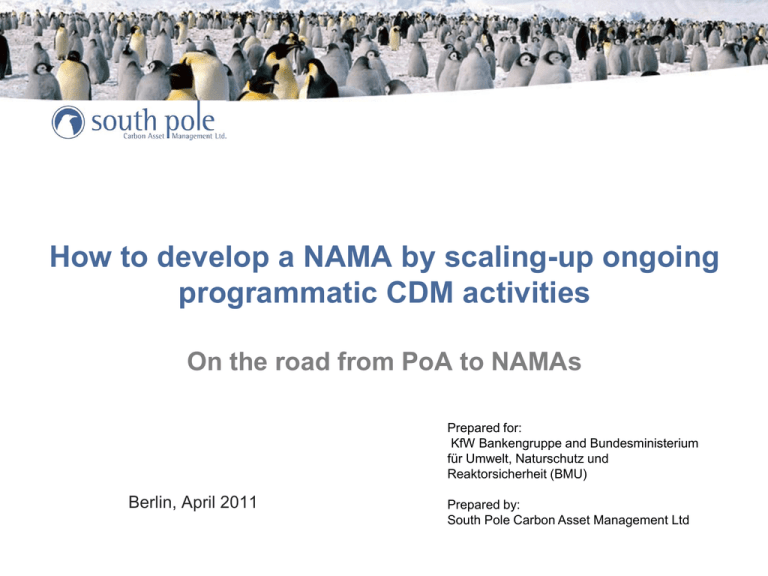
How to develop a NAMA by scaling-up ongoing programmatic CDM activities On the road from PoA to NAMAs Prepared for: KfW Bankengruppe and Bundesministerium für Umwelt, Naturschutz und Reaktorsicherheit (BMU) Berlin, April 2011 Prepared by: South Pole Carbon Asset Management Ltd Approach • Imagine you are the head of the DNA in a developing country. • Your Minister of Environment calls on you to please come up with a concrete design for a pilot NAMA for your country. • She wants something very concrete and workable. • You have never done this before but you then have a brilliant idea: – why not just look at the PoA that was submitted for approval recently and see whether you can use it and its operational design elements as a starting point for the design of a concrete NAMA. • What steps do I have to take to get there? 2 Introduction to the Study • Key Observation • A NAMA includes design elements that are structurally similar to PoA • Questions • How can PoAs act as starting points to scale-up mitigation actions within a NAMA framework? • Which PoA design elements are useful for NAMA design? • What concrete suggestions can we provide to a NAMA designer who is tasked with the development of a NAMA using key building blocks of an existing PoA? • Which recommendations can we provide going forward? • Approach • Develop a methodological framework for scaling-up PoA • Apply this method to four case-study • Analyze results and prepare recommendations 3 Methodological Framework for Scaling Up PoA Guidance for NAMA designers • Module 1: Understand the PoA: what is its scope, eligibility criteria, implementation arrangements, which GHG emission categories does it target? • Module 2: Analyze four key technical PoA design elements re: their suitability for scaling up: • • • • eligibility criteria, baseline setting procedure, MRV process and PoA management Use the outcome of this process to identify if PoA design is a) already fully applicable, b) needs to be adjusted or c) needs to be developed for NAMA design. • Module 3: Evaluate the domestic policy and institutional framework to assess whether the existing framework is supportive of NAMA implementation or not. • Module 4: Identify follow-up actions for NAMA readiness based on the need for adjustments and new designs as identified in module 2. 4 Module 2: Guiding Key Questions Eligibility Criteria • What are the PoA’s eligibility criteria? • Should the eligibility criteria be adjusted to include additional activities under a NAMA, such as expansion to other sectors and interventiontypes? • Should the eligibility criteria be adjusted to be able to scale-up activities through the involvement of additional implementation entities? • Is the PoA limited to a region? Should its geographical coverage be increased to a national scale? • Should the eligibility be adjusted to target emission reductions from the same IPCC GHG emission categories under a NAMA? 5 Module 2: Guiding Key Questions Baseline Setting • How is the baseline set in the PoA? • Is the baseline setting applicable to a NAMA? • Can the baseline be adapted by introducing standardization elements? • Can the baseline be simplified in the context of a NAMA? • Can the PoA baseline be used to set targets for the NAMA? 6 Module 2: Guiding Key Questions MRV Procedures • What are the key monitoring requirements of the PoA? • Are the PoA monitoring requirements workable in a NAMA context or would they be too difficult to implement? • Can a NAMA-level GHG inventory and its related MRV system be upgraded and operated using the PoA as a starting point? • Who is responsible for monitoring and managing the verification process? • What is the capacity of the relevant entities in the PoA to estimate, collect and manage GHG emissions in a NAMA context? 7 Module 2: Guiding Key Questions PoA Management • How is the PoA management structure set-up? Who is managing the CME? • Could the CME play a crucial role in managing a NAMA? • If not, would it be possible to transform the PoA CME into an entity with the institutional capacity to manage a NAMA? • Are the current incentives/regulations sufficient to successfully manage a NAMA? If not, what additional incentives/regulations would be needed to successfully manage a NAMA? 8 NAMA Draft Design Sheet Uganda Country: Uganda Scope and target Eligibility criteria Fit with existing act. / value-add Baseline MRV procedures Sub sector: Grid-connected RE Development in East Africa Scope: grid-connected renewable energy generation through a feed-in-tariff and carbon credit generation. Target: increase share of RE in the generation mix above baseline levels. • All grid-connected RE technologies (not only small-scale), • Large-scale interventions, including hydro, • Fuel-switching activities. • Strongly supports existing support mechanisms • The NAMA baseline is identical to the PoA baseline • NAMA MRV can be based on CDM MRV requirements. • Data is generally available. Proposed • CME is experienced to provide NAMA relevant support services but not NAMA structure coordinator, i.e. Uganda Electricity Board Incentive system/ • Negotiated feed-in-tariffs (usually low). Additional support could be: regulations - Concessional financing for the construction of new RE facilities and/or - Supplemental payments to feed-in-tariffs (per green kWh) to increase financial attractiveness of new RE development Link NAMA – • LDC status: eligible for post 2012 EUETS. Carbon market • No pressure to scale-up to NAMA unless for perceived additional benefits, i.e. support payments above financed through international support mechanism 9 Lesson-learnt & Recommendation PoA elements can serve as building blocks for NAMA design Design Element Technical criteria that provide an “objective” basis to assess eligibility of a facility or activity (type of facility, unit sizes, type of intervention ..) Baseline Standardized elements that have been developed for Setting CDM methodologies:: large-scale benchmarks (carbon intensity of power grid, national or regional NRB usage rates) deemed savings status-quo baselines modelled baselines MRV Based on deemed savings and inventory of activities/interventions (Nepal) Focus on large emission sources with simple MRV requirements that facilitate cost-effective MRV on facility level (e.g. India, Uganda case study) Implementation CME already operating at same scale as NAMA and is and Operation integral part of existing support mechanisms Eligibility Criteria PoA Elements Applicable for NAMA Non-applicable for NAMA Criteria that are subject to interpretation, i.e. driven by additionality assessment. Baseline setting procedures that are very specific to single installations or based on baseline option ranking. Project-level accounting of leakage (e.g. Tunisia case study) Project-level accounting of small emission sources CME involved in small subset of NAMA scope. Recommendation: a systematic assessment of NAMA suitability of CDM methods. 10 Lesson-learnt & Recommendation Key Differences between PoA and NAMA Criteria NAMA PoA Environmental Integrity Managed on the sectorlevel Managed on the activity level MRV For all GHG sources that meet eligibility criteria Participating GHG sources only Incentives Carrots (different flavors) and sticks Carrots only (one type only (CER)) Baseline setting Political: “appropriate” Pseudo-technical: “additional” 11 Lesson-learnt and Recommendation Integration facilitates scaling-up, but avoidance of double-counting of ER must be managed using a robust approach • Strong integration of PoA and domestic policies facilitates scaling-up • Recommendation • Ensure strong policy integration in the design of PoAs to facilitate the scaling-up to NAMAs. • Co-existence of NAMAs and PoAs in the same sector is possible if double-counting is avoided using a robust approach • A NAMA (contributing to domestic targets) competes with PoA (contributing to third Party targets): how to differentiate which ER count towards domestic energy efficiency target vs. carbon credits? • Recommendation • The only and most robust solution in the short-term is to: i) issue CERs to the PoA and then ii) deduct those issued CERs from the NAMA achievement. PoA reform and NAMA design agenda need to connect to address double-counting (among other issues). 12 Lesson-learnt and Recommendation Gain more practial experience with scaled-up PoA and pilot NAMA • More real life experience with PoA is needed to better understand key scaling-up issues and to inform PoA reform agenda • More practical experience with NAMA design will facilitate negotiation process to define operationalization of NAMA concept. • Recommendation • Launch pilot NAMA that are driven by existing and suitable PoA and examine their fit into the domestic policy landscape. • Examine how the role of PoA in NAMA framework contributes to PoA reform/streamlining of rules. 13 Open Issues that require further investigation • Double Counting • Coordination between PoA & NAMA procedures to ensure simplification and coexistence • Standardization potential • JI-style simplification • De-centralization of CDM EB authority for PoA under NAMA • Guidance for AWG LCA re NAMA design • Credited NAMA = supported NAMA plus PoA and/or new mechanism? 14 Thank You for Your Attention Ingo Puhl i.puhl@southpolecarbon.com Tel +66 2 678 8979 15 Back-Up Slides 16 The Result: a NAMA that co-exists with a PoA = a supported NAMA with PoA to provide “crediting” function • PoA is established – Standard process • Host country defines NAMA – Through systematic scale-up of PoA using useful and adjustable PoA design elements – Clarifies procedure for avoidance of double-counting of emission reductions Domestic & supported actions PoA CPA • NAMA and PoA operate – PoA: CDM MRV, NAMA: NAMA MRV – Using mix of (integrated) incentives – NAMA compliance management takes account issued PoA CER. • PoA is driven by NAMA policy NAMA target sector emissions • objectives This design provides full crediting functionality on NAMA level using existing (operational) mechanism Sector emissions (BAU) in country A (monitored in accordance with intl. rules) 17 Introduction to Market Based Mechanisms Using price signals to identify & implement least-cost abatement options To reduce the cost of complying with a defined emissions cap 18 Context: Scaling up of baseline & credit mechanisms CDM Project-by-project approach • Every project needs to establish Sector emissions in country A (not monitored (well)) – Eligibility/additionality – Emission Baseline – MRV plan • Pass UN validation and registration • Monitor, report and complete verification • CDM projects • of carbon credits Driven by initiative of project owners, not policy High complexity, high cost that create commercial risks and access barriers for small projects 19 Context: Scaling up of baseline & credit mechanisms Programmatic Approach • Program needs to establish Sector emissions in country A (not monitored (well)) – – – – – Eligibility/additionality Emission Baseline MRV plan CME Operating Structure Pass UN validation and registration • Activities need to: – Complete inclusion – MRV of carbon credits PoA CPA • Driven by “aggregator” & public policy • Reduced complexity & cost for activities 20 Context: Scaling up of baseline & credit mechanisms Domestic, Supported, Credited NAMA • Host country defines: Domestic & supported actions Actual NAMA emissions in country A (monitored in accordance with intl. rules) – – – – – Scope/coverage/activities NAMA baseline and target Requested support Implementation arrangements Crediting: Benchmarks/baselines for “surplus” actions (procedures not defined) • Host country registers & operates NAMA – Regular MRV of all NAMA sources – Implement mix of incentives, incl. carbon credits for surplus activities – Emissions “true-up” • Driven by domestic policy priorities • Implementation of activities facilitated by • NAMA target sector emissions incentives and regulation Discussion on credited NAMA postponed to December 2012 Sector emissions (BAU) in country A (monitored in accordance with intl. rules) 21 Drivers for Scaling-Up from PoA to NAMA • EU limitation on importing CER from project-based approaches • Sector-baselines might open the door for “NAMA CER” • “Mainstreaming” international cooperation mechanisms into domestic policy • Potentially simplified PoA implementation modalities for PoA under a NAMA • Learning from existing mechanisms (vs. reinventing the wheel) 22 PoA Case Studies and their NAMA Scale Equivalent Country PoA Scope NAMA Scope Uganda Small Scale Hydro Power India Energy Efficiency in SME Steel Industry Integrated payments of carbon credits and FiT for grid connected RE development Energy Efficiency in Energy Intensive SME Industries Nepal Domestic Biogas Development Energy Efficient Roofs Tunisia Low Carbon Rural Development Low Carbon Housing 23 Next Steps Strengthen NAMA readiness Country: Uganda Sub sector: Grid-connected RE Development Fit with existing activities / valueadded Baseline MRV procedures Proposed structure Incentive system/ regulations Link NAMA – Carbon market To prepare a concrete design of a supported NAMA based on supplemental payments for RE and associated supporting activities. n.a. Improve the quality and efficiency of data collection (including automation), develop country-specific fuel emission factors. See above under “fit with existing activities” See above under “fit with existing activities” To conduct a high-level policy dialogue with the Government re: their interest to participate in a pilot NAMA in relation to the development of grid-connected renewable energy. 24 Next Steps Strengthen NAMA readiness India EE for Energy-Intensive SME Industries Follow-up Action for NAMA Readiness Eligibility criteria • Evaluate/assess the potential for expansion of furnaces and burners in similar energy-intensive SME industrial sectors, including power and steam generation, fertilizer, cement, aluminum, textile, pulp & paper, glass, etc. • Create a useful classification system/ categories of equipments (size, etc) for the development of category-specific benchmarks. Fit with existing • Obtain detailed information on the applicability of the Indian energy efficiency scheme (current phase) and its planned future expansion. activities / • Assess the potential interaction between a PoA, the NAMA and the EEC scheme. value-added • Develop standardized baselines for this equipment type based on CDM method AMS II.D, applicable version. MRV procedures • Develop MRV procedures for collecting and analyzing activity data for this equipment type, (e.g. energy use fuel requirements, output) and design MRV infrastructure (e.g. who collects what, how often, and under what mandate). Baseline Proposed structure Incentive system/ regulations Link NAMA – Carbon market • Assess coordination between NAMA and PoA coordinating entities (capacity building needs). • Evaluate take-up of EE investment activity and assess performance of the existing PoA incentive system after first year of PoA operation. • Offer support to the Indian Govt. to design a conceptual framework for a NAMA in this sector and explore its interaction with a PoA. 25 NAMA Draft Design Sheet India Country: India Sub sector: EE in SME Productive Industries • Scope: to improve the energy efficiency of furnaces and burners in energy-intensive SME industries throughout India. • Target: to reduce energy consumption by at least 20% per unit of production. Eligibility criteria • All furnaces & burners operating in energy-intensive SME industries that are not covered under the India EEC scheme incl. measures that do not comply with AMS II.D. Fit with existing • Contributes to 20-25% emission intensity reduction target per unit of GDP by 2020. activities / value-add • Supplements energy efficiency certificate mechanism (currently for large energy users only) Baseline • NAMA-level baseline data for SME is currently missing. • NAMA baseline should be established retroactively and be disaggregated to the facility level. • CPA contribute a share of its CER to NAMA target. MRV procedures • Mandatory reporting of activity data for all facilities covered by this NAMA (BEE managed) • CPA already report to CDM requirements. Scope and target Proposed structure Incentive system/ regulations Link NAMA – Carbon market • NAMA coordinated under National Mission for Enhanced Energy Efficiency (i.e. by BEE) • NAMA-level monitoring and reporting by BEE • Technical advisory and financial support by ISTSL and SIDBI • All activities shall be eligible for the financial support provided under the 2001 Energy Conservation Act and SIDBI EE financing facility (plus CER for PoA eligible activities). • NAMA shall not encumber the CER granted to the PoA • Issued CER need to be deducted from NAMA achievements when determining NAMA target compliance. • NAMA could purchase CER from this PoA (or any other) to cover an eventual shortfall of emission reductions on the NAMA level. 26
